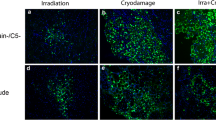Summary
A problem with the use of muscle grafting as a therapeutic procedure is to produce a graft functionally adequate to replace a muscle of complex architecture, such as a sphincter muscle. We thought it might be possible to use dead cadaver muscles, repopulated by the patient's own muscle precursor cells (mpc), to reconstruct muscles whose anatomy would be imposed by the framework of dead muscle and whose genetic constitution would be determined by the mpc. Here we show, in the mouse, that an extensor digitorum longus (EDL) muscle, killed by repeated freezing and thawing, repopulated with mpc and grafted into a nu/nu or tolerant AKR host mouse, is capable of supporting muscle formation. By using the allotypic isoenzyme forms of glucose-6-phosphate isomerase as markers, we have shown that the newly regenerated muscle in such grafts is derived mainly from the implanted mpc, but also to some extent from the host mouse's own mpc. By 50–70 days after grafting, new muscle fibres were found to constitute up to 70% of the graft. Many fibres had assumed diameters in the normal range for mouse muscle, often having peripherally placed nuclei. These findings raise the possibility of the therapeutic use of such grafts. To our surprise, dead EDL muscle grafts into which no mpc had been implanted were also the site of good muscle regeneration. New-formed muscle in these grafts was shown to be derived entirely from mpc which must have migrated into the graft from the host. Investigation of the mechanisms underlying this phenomenon should further our knowledge of factors which regulate the proliferation and movement of dormant mpc in adult animals.
Similar content being viewed by others
References
Billingham, R. E., Brent, L. &Medawar, P. B. (1956) Quantitative studies on tissue transplantation immunity III: Actively acquired tolerance.Phil. R. Soc. London. Ser. B 239, 357–424.
Bischoff, R. (1981) Activation and proliferation of muscle satellite cells on isolated fibres.J. Cell Biol. 91, 342a.
Carlson, B. M. (1970) The regeneration of entire muscles from minced fragments. InRegeneration of Skeletal Muscle and Myogenesis (edited byMauro, A., Shafiq, S. A. &Milhorat, A. T.), pp. 25–37. Amsterdam: Excerpta Medica.
Carlson, B. M. (1982) Development of a free muscle graft, InDisorders of the Facial Nerve (edited byGraham, M. D. &House, W. F.), pp. 487–97. New York: Raven Press.
Carlson, B. M. &Gutman, E. (1976) Free grafting of the extensor digitorum longus muscle in the rat after marcaine pretreatment.Exp. Neurol. 53, 82–93.
Curtis, A. S. G. (1960) Area and volume measurements by random sampling methods.Med. Biol. Illustr. 10, 261–6.
Ghins, E., Colson-Van Schoor, M., Maldague, P. &Maréchal, G. (1985) Muscle regeneration induced by cells autografted in adult rats.Arch. Int. Physiol. Biochim. 93, 143–53.
Ghins, E., Colson-Van Schoor, M. &Maréchal, G. (1984) The origin of muscle stem cells in rat triceps surae regenerating after mincing.J. Musc. Res. Cell Motility 5, 711–22.
Ghins, E. Colson-Van Schoor, M. &Maréchal, G. (1986) Implantation of autologous cells in minced and devitalized rat skeletal muscles.J. Musc. Res. Cell Motility 7, 151–9.
Grounds, M. D. &Partridge, T. A. (1983) Isoenzyme studies of whole muscle grafts and movement of muscle precursor cells.Cell. Tissue Res. 230, 677–88.
Grounds, M., Partridge, T. A. &Sloper, J. C. (1980) The contribution of exogenous cells to regenerating skeletal muscle: an isoenzyme study of muscle allografts in mice.J. Pathol. 132, 325–41.
Jockusch, H., Mehrke, G. &Füchtbauer, E-M. (1983) Beating heart muscle in a skeletal muscle bed.Exp. Neurol. 81, 749–55.
Partridge, T. A., Grounds, M. &Sloper, J. C. (1978) Evidence of fusion between host and donor myoblasts in skeletal muscle grafts.Nature (Lond.) 273, 306–8.
Partridge, T. A. &Sloper, J. C. (1977) A host contribution to the regeneration of muscle grafts.J. Naurol. Sci. 33, 425–35.
Schultz, E., Jaryszak, D. L., Gibson, M. C. &Albright, D. J. (1986) Absence of exogenous satellite cell contribution to regeneration of frozen skeletal muscle.J. Musc. Res. Cell Motility 7, 361–7.
Vandenburgh, H. H., Sheff, M. F. &Zacks, S. I. (1984) Soluble age-related factors from skeletal muscle which influence muscle development.Exp. Cell Res. 153, 389–401.
Venkatasubramanian, K. &Solursh, M. (1984) Chemotactic behaviour of myoblasts.Dev. Biol. 104, 428–33.
Vracko, R. &Benditt, E. P. (1972) Basal lamina: the scaffold for orderly cell replacement.J. Cell Biol. 55, 406–19.
Watt, D. J., Lambert, K., Morgan, J. E., Partridge, T. A. &Sloper, J. C. (1982) Incorporation of donor muscle precursor cells into an area of muscle regeneration in the host mouse.J. Neurol. Sci. 57, 319–31.
Watt, D. J., Morgan, J. E., Clifford, M. A. &Partridge, T. A. (1987) The movement of muscle precursor cells between adjacent regenerating muscles in the mouse.Eur. J. Anat. (in press).
Yasin, R., Van Beers, G., Nurse, K. C. E., Al-Ani, S., Landon, D. N. &Thompson, E. J. (1977) A quantitative technique for growing human adult skeletal muscle in culture starting from mononucleated cells.J. Neurol. Sci. 32, 347–360.
Author information
Authors and Affiliations
Rights and permissions
About this article
Cite this article
Morgan, J.E., Coulton, G.R. & Partridge, T.A. Muscle precursor cells invade and repopulate freeze-killed muscles. J Muscle Res Cell Motil 8, 386–396 (1987). https://doi.org/10.1007/BF01578428
Received:
Issue Date:
DOI: https://doi.org/10.1007/BF01578428




